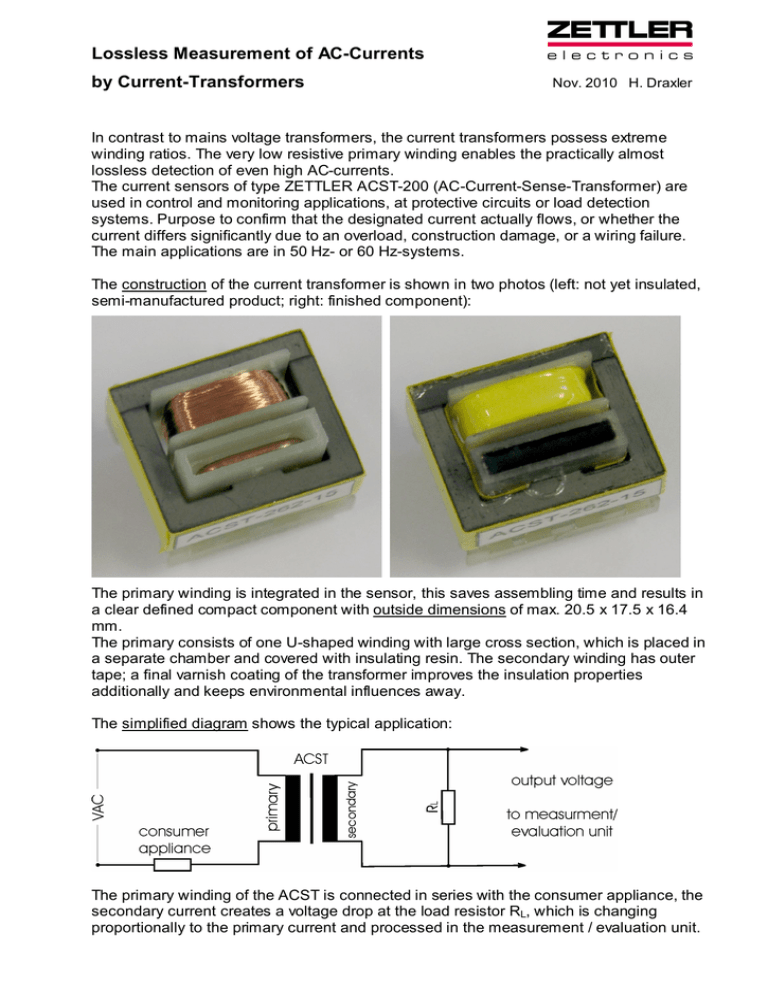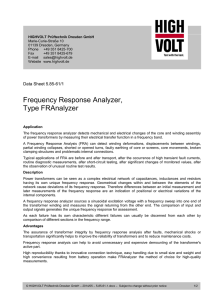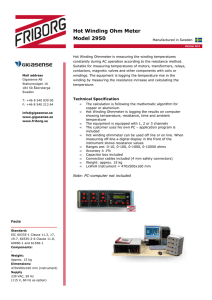Applications Notes - Zettler Electronics
advertisement

Lossless Measurement of AC-Currents by Current-Transformers Nov. 2010 H. Draxler In contrast to mains voltage transformers, the current transformers possess extreme winding ratios. The very low resistive primary winding enables the practically almost lossless detection of even high AC-currents. The current sensors of type ZETTLER ACST-200 (AC-Current-Sense-Transformer) are used in control and monitoring applications, at protective circuits or load detection systems. Purpose to confirm that the designated current actually flows, or whether the current differs significantly due to an overload, construction damage, or a wiring failure. The main applications are in 50 Hz- or 60 Hz-systems. The construction of the current transformer is shown in two photos (left: not yet insulated, semi-manufactured product; right: finished component): The primary winding is integrated in the sensor, this saves assembling time and results in a clear defined compact component with outside dimensions of max. 20.5 x 17.5 x 16.4 mm. The primary consists of one U-shaped winding with large cross section, which is placed in a separate chamber and covered with insulating resin. The secondary winding has outer tape; a final varnish coating of the transformer improves the insulation properties additionally and keeps environmental influences away. The simplified diagram shows the typical application: The primary winding of the ACST is connected in series with the consumer appliance, the secondary current creates a voltage drop at the load resistor RL, which is changing proportionally to the primary current and processed in the measurement / evaluation unit. The acquisition of the measuring signal occurs galvanically separated, thus the sensor can be implemented at any point within the electrical circuit. The preferred type of the ACST-200 series, the part ACST-262, works at a winding ratio of 1:1500; it covers most of all applications. Upon request also types with lower winding ratio (1:50 … 1:1000) can be supplied. (Reference ACST data sheet) The output voltage at the load resistor depends on the primary current and the applied load resistor. In the outgoing inspection at the end of the production, a test is conducted under reference conditions. At the ACST-262 these are 10 Arms / 50 Hz / load resistor 200 ; the corresponding specified output voltage is 1233 mVrms at a tolerance of ± 5 %. The diagram shows typical values for different load resistors; the desired output voltage can be adapted in a wide range. At a load resistor of up to 200 it is linear in the whole range of primary current. The diagram is valid for mains frequencies of 50 Hz and 60 Hz. If – particularly at lower currents – larger output voltages are needed, this can be realized by choosing a higher load resistance. It is then recommended to carry out adequate measurements in the real application using samples of the ACST; this is also imperatively essential at higher frequent or non-sinusoidal measuring currents. The primary winding is designed for steady currents of up to 30 Arms. Its DC-resistance represents ≤ 600 µ only and its impedance in 50 Hz applications is still typically < 1 m. Thus at e. g. 10 Arms primary current an apparent power loss of only about 0.1 VA is needed; to create a similar measuring voltage drop at a shunt resistor, a value of 100 mwould be required – which denotes an apparent power of 10 VA! If lamp loads, capacitive loads or transformers are switched on, very short time high current pulses are distinctive. Longer lasting higher currents appear for instance at the start-up phase of motors. Even such overcurrents in the primary circuit are survived by the ACST without problems. How they influence the temperature in the component is shown in the diagram; the cross section of the current feeder has important influence: A current of 100 Arms at a copper cross section of 4 mm 2 is in 5 seconds increasing the temperature in the primary winding by 37 K and at the solder connection by 27 K. At a supply cross section of 1.5 mm 2 only, the corresponding values are 57 K / 72 K; as the final temperature of the windings must not exceed 130 °C, in this example the ambient temperature is limited to max. 70 °C. At high currents it has to be considered, that the sensor is no longer working in its linear range; the output voltage may be reduced to a great extent. Due to the not negligible power loss in the primary winding at high currents, the steady current is limited to 30 Arms; the maximum ambient temperature is 85 °C at currents of ≤ 20 Arms and 70 °C at currents of > 20 Arms. In general the user has to observe that the cross sections of the current paths are sufficient, to limit the external heating. Thermal influences reduce the output voltage of the ACST only marginally: At a steady primary current of 30 Arms the temperature in the secondary winding is increased by about 20 K; the output voltage declines by 2 %. An increase of the ambient temperature from 20 °C to 85 °C reduces the output voltage by 5 %. Due to the construction using two separated winding chambers and the fully insulated primary winding, the ACST assures a very good insulation between primary and secondary. The value for „solid insulation“ is > 1.5 mm. The creepage and clearance distances are 5.5 mm at the standard version; thus the requirements for basic insulation according to IEC 60664-1 (VDE 0110-1) are exceeded by far even at overvoltage category III and pollution degree 3. If for special applications a clearance and creepage of 8 mm are required, this is ensured by another available version: an additional cover – mounted at the bottom side – increases the insulation distance. The dielectric strength between primary and secondary winding is specified at 4000 Vrms and 60 seconds test time. The corresponding test in series production is carried out with 4400 Vrms / 1 second. The current sensors of series ACST-200 are reasonably priced, universally implementable components for measuring and supervising AC currents. The production is certified according to ISO 9001. An ACST data sheet may be downloaded from www.ZETTLERelectronics.com.


